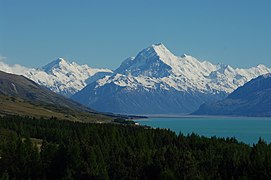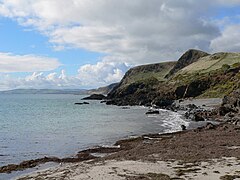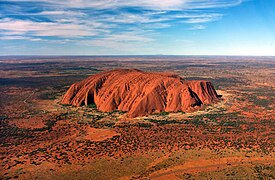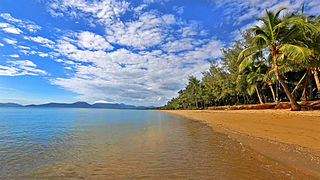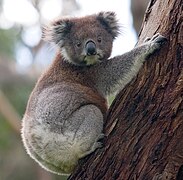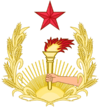Matharius
Federal Republic of Valentir République fédérale de Valentir | |
|---|---|
Motto: Arduus ad solem "Striving towards the sun" | |
Anthem: "TBD" | |
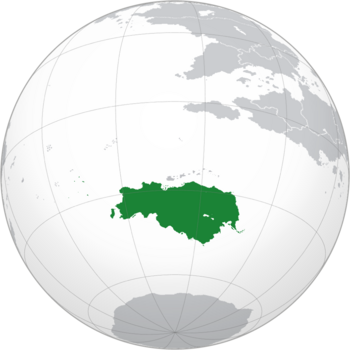 Location of the Federal Republic in Kylaris | |
| Capital | |
| Largest city | |
| Official languages | Estmerish Gaullican |
| Demonym(s) | Valentirian |
| Government | Federal semi-presidential constitutional republic |
| Helene Pauline (PRP) | |
| Gaultier Babineaux (VFL) | |
| Aidan Bishop (NAWP) | |
| Thibault Devaux | |
| Genevieve Cantelli (VFL) | |
| Lucrezia Fiorentini (VFL) | |
| Legislature | Parliament |
| Senate | |
| Assembly | |
| Independence from the Estmerish Empire | |
| 1629 | |
| 1714 | |
| 4 September 1825 | |
| 11 January 1912 | |
| 13 June 1912 | |
| 19 July 1912 | |
| Area | |
• Total | 5,675,532 km2 (2,191,335 sq mi) |
• Water (%) | 1.34 |
| Population | |
• 2019 estimate | 55,051,345 |
• 2015 census | 51,690,103 |
| GDP (PPP) | 2019 estimate |
• Total | $2.604 trillion |
• Per capita | $47,318 |
| GDP (nominal) | 2019 estimate |
• Total | $2.584 trillion |
• Per capita | $46,952 |
| Gini (2019) | medium |
| HDI (2019) | very high |
| Currency | Valentirian Pound (VP, £) |
| Date format | dd-mm-yy |
| Driving side | left |
| Calling code | +61 |
| Internet TLD | .va |
The Federal Republic of Valentir (Gaullican: République Fédérale de Valentir) is a sovereign country comprising of the mainland of the Valentirian continent, the island of New Embria and numerous smaller islands. It is a federal republic composed of 15 constituent provinces, three territories, and various possessions. At 5.6 million km2 and with over 55 million people, Valentir is the largest country in Sublustria and the 5th largest in the world by total area and the twenty-second most populous country. The capital is Valeins and the largest city is Harborough, an important global city and financial centre with an urban population of 5.1 million. The country's other major metropolitan areas are Valanjou, Dunwall, New Lumbridge, Montsimmard, Winterley and Haussimont. Fourteen of the provinces are on the mainland of the continent. The Province of New Embria is an island located off the west coast of the continent. The various territories and island possessions are scattered about the Sublustrian Ocean, the furthest being St. Richard Island. The extremely diverse geography, climate, and wildlife of Valentir makes it one of the world's 4 megadiverse countries.
Valentir is considered a regional and middle power in international affairs and is a founding member of the Community of Nations, International Council for Democracy, C20, International Trade Organization, Global Institute for Fiscal Affairs, Sublustrian League, Council for Economic Co-operation and Development (CECD), Cavignac Group, and other international organizations.
A highly developed country, Valentir possesses the Xth largest economy in Kylaris. It has a high-income mixed market economy, with the world's Xth highest per capita income. Valentir benefits from a highly skilled and educated workforce; it has among the world's largest proportion of citizens holding a tertiary education degree. Its economy is primarily based around finance, telecommunications, mining, energy and manufacturing.
Having the second-highest human development index and the fourth-highest ranked democracy globally, the country ranks highly in quality of life, health, education, economic freedom, civil liberties and political rights, with all its major cities faring well in global comparative livability surveys. It is one of the world's most ethnically diverse and multicultural nations, the product of large-scale immigration from many other countries. Valentir has the world's Xth largest immigrant population, with immigrants accounting for 17.3% of the population.
Etymology

The name Valentir is derived from the surname of Amathian explorer Constantin Valentir, who completed several voyages across the Vehemens Ocean under the auspices of the Monarchs of Gaullica. In 1629 Valentir and the crew of HMS Marguerite became the first Eucleans to make landfall on the Valentirian continent. Subsequent Gaullican expeditions would eventually receive colonial charters from King Francois II.
In all official Gaullican documentation from that time Valentir is referred to as Terra Illustris (Solarian: Illustrious Land), a reference to the continents vast landscapes and natural resources. The continent would only be referred to as Valentir after the first Estmerish explorers arrived in the early 1640's. Estmerish cartographer Some Name produced a world map in 1647 on which he named the behemoth continent Valentir in honour of Constantin. At the time it is unknown why a Gaullican backed explorer was chosen for the honour, but historical records eventually revealed that Constantin provided the Estmerish details regarding his findings shortly after his return to Euclea. By the late 18th century Valentir was the international term applied to the continent.
- <Maori name>
- <Xiaodongese name>
History
The first recorded Euclean sighting of the Valentirian mainland, and the first recorded Euclean landfall on the Valentirian continent (in 1629), are attributed to the Gaullicans. The first ship and crew to chart the Valentirian coast and meet with Arateran people was the Couronne captained by Gaullican navigator, Jean-Luc de Valmont. The first settlement, Valanjou, was founded in 1631 as the capital of the Viceroyalty of Ghislaine, the first Gaullican colony. The island continent would be officially named Valentir, after royal decree awarded Valentin de Valeins a charter to establish and oversee colonisation of the island. The establishment of the Viceroyalties of Valmont (1633), Serault (1635), Laussonne (1636), Talissieu (1636), and Giseroux (1640) would follow.
Estmerish colonisation began in 1644 with the founding of New Ardougne and its capital, Dunwall, in north-eastern Valentir by Sir Martin Black, a privateer in the service of the Estmerish Royal Navy. The settlements of Harborough (1645), Draynor (1647), Axminster (1651), New Lumbridge (1653), and Amaranthine (1655) further established an Estmerish foothold on the continent. By the late 17th century most of the coast was controlled by either the Estmerish or Gaullicans. Competition between the rival maritime powers spurred rapid expansion. Conflicts between local tribes and petty kingdoms served as a means of proxy warfare between the colonial settlers. Territorial boundaries were in a state of constant dispute as a result of the Gilded Wars. The turmoil was worsened by the rise of piracy and banditry, both of which would see golden ages during the early 18th century.
A prominent feature of Estmerish expansion was the establishment of Shires, a series of homesteads centred around extensive grazing lands for cattle, sheep, pigs and horses. Shires became commonplace by the late 17th century and formed the cornerstone of Estmerish colonial life. The prominent Estmerish founding families expanded their estates steadily during the early 17th and 18th centuries. Overtime the estates became host to a familial manor at the heart of the estate, quarters for the estate's household, and all the necessary accessories of a traditional farmstead. These estates became known as Bans, which was used to denote the head of the estate as well. The word finds its origins from Amathian settlers who found work in the fields of the Bannorn, a huge collective of Bans in Western Valentir, specifically Westcliff, Harwich, and Rotorua.
Early 20th century
Valentirian Civil War (1911-1915)
The Fair Society
Great War
Post-war period
Modern history
Environment
Geography
Surrounded by the Vehemens and Lumine oceans, Valentir is separated from the Asterias by the Sublustrian Sea and from Coius by the Banfura Sea, with the Sublustrian Sea lying off the New Ardougne coast, and the Banfura Sea lying between Valentir and Coius. The world's smallest continent and fourth largest country by total area, Valetir — owing to its size and isolation — is often dubbed the "island continent", and is sometimes considered the world's largest island.
The Great Barrier Reef, the world's largest coral reef, lies a short distance off the north-east coast and extends for over 2,000 kilometres (1,240 mi). Mount Fairmaiden, claimed to be the world's largest monolith, is located in Talissieu. At 3,754 metres (12,316 ft), Mount Tāwhirimātea is the highest mountain on the Valentirian mainland. Western and Eastern Valentir are marked by the White Mountains and Dragon's Spine Alps, both of which run parallel to their respective coasts. The Western and Southern coastal regions of the continent feature temperate climates and is broadly comprised of forest, woodland, wetland, grassland, and rainforest. The Northwestern region tends to be drier, especially towards the coast, and is home to Valentir's largest desert as well as several dunes and dry grasslands. The Northeast is remarkably more temperate, albeit dry, with extensive grasslands and woodland. Central Valentir is a mixture of a dry, warm climate that is fed by large river basins and snow and is dominated by fertile grasslands and forests.
Climate
Biodiversity
Politics
Government
Valentir has been since independence in 1912 a federal semi-presidential republic with a parliamentary system of governance, with the President of Valentir serving as head of state and the Prime Minister of Valentir serving as head of government. Power is divided between the legislative, executive, and judicial branches of government, with each branch checking the power of one another. This system of checks and balances was inspired by the X.
The President of Valentir is elected through a two-round system of voting to serve a 5 year term. While there are no term limits in the Constitution, it has become tradition for presidents to only serve one term. To date no President has served more than one term in office. Executive power lies in the hands of the President who, unlike heads of state in parliamentary republics, maintains a degree of executive authority and influence in the government, especially concerning foreign affairs, national security, and the promulgation of laws. The President also may have a hand in the legislature, working with the Prime Minister to influence Parliament's agenda and direct the legislature, though this is very dependent on whether or not the President and Prime Minister share the same political party. Should the President and Prime Minister be from opposing parties it is customary that the president focus primarily on foreign affairs and the Prime Minister focus on internal affairs in what is commonly referred to as cohabitation. In their capacity as head of state the President is also the commander-in-chief of the Valentirian National Defence Force and is the chief diplomatic representative of the nation abroad. Helene Pauline of the Progressive Republican Party is the current President of Valentir, in office since 5 March 2015.
According to the Constitution legislative power is held solely by the Parliament of Valentir, a bicameral legislature consisting of the Senate and the Assembly. The Senate is composed of 150 Senators, 10 from each of the 15 provinces. Senators are popularly elected under the single transferable vote system of proportional representation. As such the chamber features a multitude of parties vying for power. The Assembly is composed of 600 Members of Parliament, each elected to represent a single member constituency, officially known as an electoral division (commonly referred to as electorates or seats). Members of the Assembly are elected using first-past-the-post voting. The Senate and Assembly convene at Fairfax Palace in the nation's capital, Valeins.
The Constitution states that presidential, senate, and assembly elections must be held 5 years after the previous election. While it is the mandate of the constitution to have elections every 5 years, the current Prime Minister may call for a snap election in Parliament before that time. A snap election may only occur if at least two-thirds of the Senate and Assembly vote in favour of the motion.
The Prime Minister of Valentir is the chief legislative official and a member of the Assembly. The Prime Minister is not an elected official, rather they are a Member of Parliament. The position of prime minister belongs to the person most likely to command the confidence of the Assembly; this individual is typically the leader of the political party or coalition of parties that holds the largest number of seats in that chamber. The prime minister chooses a cabinet, on advice from the president, and its members are formally appointed by the president to form the Cabinet of Valentir, the governing apparatus of the Federal government of Valentir. Johnathan Bennett of the Progressive Republican Party is the current Prime Minister of Valentir, in office since 11 June 2016.
Law and criminal justice
Foreign relations
Valentir is recognized as a middle power for its role in international affairs with a tendency to pursue multilateral solutions. However, beginning in the 21st century, Valentir has been regarded as an emerging great power in concert with Satucin through its X alliance, which has expanded its economic and military influence throughout the Asterias.
Valentir's foreign policy based on international peacekeeping and security is carried out through coalitions and international organizations, and through the work of numerous federal institutions. The country possesses significant soft and hard power through its extensive web of diplomatic and military commitments around the globe. Its "special relationships" with both Estmere and Senria, as well as its membership in the C20, International Council for Democracy, and Cavignac Group have awarded Valentir significant clout within the international community.
Over recent decades, Valentir's foreign relations have been driven by a close association with Senria and the Council for Mutual Security and Development (COMSED) and by a desire to strengthen relationships in Euclea and the Asterias, particularly through La Gaullophonie and Asterian Development Council. Valentir has pursued the cause of international trade liberalisation. It led the formation of the Cavignac Group and Coius-Vehemens Forum for Economic Cooperation. Valentir is a member of the Council for Economic Co-operation and Development, International Trade Organization and Global Institute for Fiscal Affairs, and has pursued several major bilateral free trade agreements, most recently the Valentir-X Free Trade Agreement with another free trade agreement being negotiated with Mathrabumi—the Valentirian–Marathi Free Trade Agreement—and Senria and Vilcasuamanas in 2006, and as of November 2017 has put the Trans-Vehemens Partnership before parliament for ratification.
A founding member country of the Community of Nations, Valentir is strongly committed to multilateralism and maintains an international aid program under which some 60 countries receive assistance. Valentir ranks thirteenth overall in the Center for Global Development's 2017 Commitment to Development Index.
Military

The armed forces of Valentir, officially the Valentirian National Defence Force, consists of five professional service branches: the Valentirian National Army, Valentirian National Navy, Valentirian National Air Force, Valentirian National Marine Force, and Valentirian National Strategic Support Force. The VNDF is officially lead by the National Defence Council and serves as the main organ in Valentirian military command. The NDC consists of the President, who serves as Commander-in-chief, the Chairman of the National Defence Council, who is appointed on advice from the Cabinet, and the Minister for Defence, who manages the armed forces as leader of the Department of Defence. The VNDF is charged with the defence of Valentir, its territories, as well as promoting Valentir's global security interests and supporting international peacekeeping efforts. Valentir is a major contributor to CN peacekeeping missions and actively participates in disaster relief and armed conflict. Its history of international intervention dates back to the Great War and its support for the Grand Alliance.

The VNDF is a volunteer army currently consisting of 300,000 active and 450,000 reserve personnel. The budget for the fiscal year 2017-2018 allocated £62 billion to the Department of Defence, about 2.3% of the country's GDP, representing the world's Xth largest defence budget.
Valentir has a large, advanced domestic arms industry that assists in equipping its armed forces with the latest in military technology. Hannibal Weapons System, Halo Industries, AMG Transport, and a number of foreign suppliers form the bulk of government sponsored defence contracts. Domestic models include the VLAV, the Warthog Mark I, and the SCORPION. The nation's armed forces are also supplied by a number of foreign sources, the largest of which are Estmere, Satucin, and Senria.
Provinces and territories
Valentir is a federation composed of 15 provinces and three territories. Provinces have more autonomy than territories, having responsibility for social programs such as health care, education, and welfare. Together, the provinces collect more revenue than the federal government, an almost unique structure among federations in the world. Using its spending powers, the federal government can initiate national policies in provincial areas, such as the Federal Health Service Act; the provinces can opt out of these, but rarely do so in practice. Equalization payments are made by the federal government to ensure reasonably uniform standards of services and taxation are kept between the richer and poorer provinces.
The major difference between a Valentirian province and a territory is that provinces receive their power and authority from the Constitutional Devolution of Powers Act, whereas territorial governments have powers delegated to them by the Parliament of Valentir. The powers flowing from the Constitutional Devolution Act are divided between the Government of Valentir (the federal government) and the provincial governments to exercise exclusively. A change to the division of powers between the federal government and the provinces requires a constitutional amendment, whereas a similar change affecting the territories can be performed unilaterally by the Parliament of Valentir or government.
| Arms | Province | Capital | Population | Premier | Governing party | |
| Aigremont | Cavignac | 1,678,925 | François Rozenthal | AP-DS | ||
| Dryden | Clovis | 2,361,828 | Stephen Hayes | PRP | ||
| Ghislaine | Valanjou | 5,382,858 | Gaétan Guérin | RPG | ||
| Harwich | Draynor | 831,927 | Edward Hargreaves | PRP | ||
| Kensington | Axminster | 3,271,875 | Issac Barton | PRP | ||
| Laussonne | Brieuil | 2,789,426 | Dominique Perrault | A-CL | ||
| New Ardougne | Dunwall | 3,826,716 | Rosalyn Wescott | NAWP | ||
| New Embria | Winterley | 1,122,473 | Henry FitzRoy | PRP | ||
| Oneawea | Ahuimanu | 982,626 | Arcibald Waldman | VFL | ||
| Rotorua | Tāhaenui | 1,498,147 | Vanessa Duriès | VFL | ||
| Serault | Montsimmard | 3,093,544 | Jean-Pierre Cassel | VFL | ||
| Talissieu | Haussimont | 5,036,810 | Tristan Teyssier | AP-DS | ||
| Tarrington | New Lumbridge | 7,068,056 | Mark Harris | PRP | ||
| Vallois | Valeins | 4,171,253 | Vincent Gladden | PRP | ||
| Westcliff | Harborough | 8,573,639 | Emelia Mayer | NLP |
Economy
Valentir has a high-income mixed market economy which is fueled by abundant natural resources, a highly skilled labour force, a low level of corruption, and a high level of innovation. In 2019 Valentir's estimated nominal GDP was $2.584 trillion, the Xth largest in the world. It is the world's Xth largest exporter of goods, and has the largest national economy in Sublustria and Asteria Inferior.
The Ministry for Finance (Ministère des finances) is responsible for setting government expenditure and implementing government financial policy. The Federal Reserve Bank of Valentir is the country's central bank and is responsible for issuing notes and coins in the nation's currency, the pound. Provincial banks retain the right to issue their own notes, subject to retaining enough Federal Reserve notes in reserve to cover their issue. Since 1983 the Federal Reserve, headed by the Chairman of the Federal Reserve, has been responsible for setting interest rates at the level necessary to achieve the overall inflation target for the economy that is set by the Finance minister each year.
Agriculture
Valentir is a major agricultural producer and exporter, with over 525,300 employed in agriculture, forestry and fishing as of January 2016. Agriculture and its closely related sectors earn $216 billion-a-year for a 8% share of GDP. Farmers and graziers own 347,025 farms, covering 51% of Valentir's landmass. Approximately 53% of all farms across Valentir belong to the state, with a further 29% that are still owned by indigenous groups or tribes. Across the country there is a mix of irrigation and dry-land farming. Valentir leads the world with 59 million hectares certified organic, which is 17% of Valentir's agricultural land and Valentir now accounts for more than half (60%) of the world's certified organic agriculture hectares.
Valentir is one of the world's leading producers and exporters of beef, wheat, lamb, poultry, milk, vegetables, fruits and wool.
Valentir has a large wine industry, and the value of wine exports surpassed $3 billion in 2014-2015. Wine regions include the Mirabella Valley in Tarrington, Amaranthine in Westcliff, Dryden River in Kensington and the Recherche Valley in Talissieu. The key wine varieties grown in Valentir are Chardonnay, Shiraz and Cabernet Sauvignon.
Mining
Energy
In 2018, Valentir was the world's 4th largest energy producer with 27.5 quadrillions BTU, and the 11th largest energy consumer, with 10.7 quadrillions BTU. The country has significant energy resources, including 141,500,000,000 barrels of conventional oil and 2,866,000,000,000 barrels of natural gas reserves, 4 billion barrels of oil-equivalent of coal-based methane (CBM) resources, and 59 billion tonnes of recoverable coal. The extent of these reserves have led many to consider Valentir one of the energy superpowers in Kylaris.
Valentir is one of the few developed nations that is a net exporter of energy—in 2016 net exports of energy products amounted to 3.8% of GDP. Most important are the large oil and gas resources centred in Harwich and Talissieu, but also present in neighbouring Rotorua and Kensington. The vast X oil sands give Valentir the world's Xth largest reserves of oil after Zorasan and whoever else according to USGS. In Westcliff and Vallois, as well as Laussonne, Harwich, Ghislaine and Talissieu, hydroelectric power is an inexpensive and relatively environmentally friendly source of abundant energy. In part because of this, Valentir is also one of the world's highest per capita consumers of energy. Cheap energy has enabled the creation of several important industries, such as the large aluminum industries in Harwich and New Ardougne.
Infrastructure
Tourism

Tourism in Valentir is a growing sector and key to the economy of several regions of the country. The country had 38.36 million visitors in 2015, ranking in terms of the international tourist arrivals as the main destination in Sublustria and second in Asteria Inferior after Satucin. Revenues from international tourists reached $68 billion in 2014, showing a recovery from the 2005-2011 economic crisis. Historical records of 40.67 million visitors and $75 billion in receipts were reached in 2017.
Natural areas are its most popular tourism product, a combination of ecotourism with leisure and recreation, mainly sun and beach, and adventure travel, as well as cultural tourism. Among the most popular destinations are the Dragon's Spine Alps, beaches and dunes in the Northeast Region, Areyonga in the Center-West Region, beaches at Montsimmard and Clovis, cultural tourism in Valeins and business trips to Harborough.
In terms of the 2015 Travel and Tourism Competitiveness Index (TTCI), which is a measurement of the factors that make it attractive to develop business in the travel and tourism industry of individual countries, Valentir ranked in the Xth place at the world's level, second in the Asterias, after Satucin.
Demographics
| Rank | State | Pop. | Rank | State | Pop. | ||||
|---|---|---|---|---|---|---|---|---|---|
 Harborough  Shadwell |
1 | Harborough | Westcliff | 5,137,863 | 11 | Draynor | Harwich | 512,365 |  Valanjou  Valeins |
| 2 | Shadwell | Tarrington | 4,793,426 | 12 | Tāhaenui | Rotorua | 493,602 | ||
| 3 | Valanjou | Ghislaine | 2,413,217 | 13 | Cavignac | Aigremont | 487,364 | ||
| 4 | Valeins | Vallois | 2,183,717 | 14 | Clovis | Dryden | 469,246 | ||
| 5 | Haussimont | Talissieu | 1,829,911 | 15 | Amaranthine | Westcliff | 331,491 | ||
| 6 | Dunwall | New Ardougne | 1,345,771 | 16 | Verchiel | Ghislaine | 329,101 | ||
| 7 | Montsimmard | Serault | 947,611 | 17 | Ahuimanu | Oneawea | 302,483 | ||
| 8 | Winterley | New Embria | 701,337 | 18 | Sahrnia | Serault | 261,258 | ||
| 9 | Brieuil | Laussonne | 623,525 | 19 | Gwaren | Tarrington | 252,689 | ||
| 10 | Axminster | Kensington | 566,093 | 20 | Montfort | Talissieu | 206,147 | ||
Ethnic Groups
Race and ethnicity in Valentir
Languages
A multitude of languages are used by Valentirians, with Estmerish, Gaullican, and Arateran (the official languages) being the mother tongues of approximately 41%, 40% and 8% of Valentirians, respectively. As of the 2015 Census, just over 8.9 million Valentirians listed a non-official language as their mother tongue. Some of the most common non-official first languages include Senrian (927,680 first-language speakers), Marathi (701,680), Etrurian (558,850), Caldish (531,385), Xiaodongese (519,895), Floren (484,040), and Subarnan (475,645).
Valentir's federal government practices official multilingualism, which is applied by the Department of Valentirian Heritage and Multiculturalism in consonance with Section 16 of the Valentirian Constitution and the Federal Ethnic Relations Act of 1923 Estmerish, Gaullican and Arateran have equal status in federal courts, parliament, and in all federal institutions. Citizens have the right, where there is sufficient demand, to receive federal government services in either Estmerish, Gaullican and Arateran and official-language minorities are guaranteed their own schools in all provinces and territories. Since the passage of the Federal Education Standards Act in 1938 all Valentirians are mandated to learn all three official languages. As a result most Valentirians speak a minimum of three languages. An amendment of the FES Act in 1989 expanded the provision to include mandatory foreign language classes. Most Valentirian schoolchildren born after 2000 who have completed upper secondary school speak a minimum of four languages.
Religion
Valentir is religiously diverse, encompassing a wide range of beliefs and customs. Valentir has no official church, and the government is officially committed to secularism through a series of policies known as Amitié. Freedom of religion in Valentir is a constitutionally protected right, allowing individuals to assemble and worship without limitation or interference. The practice of religion is now generally considered a private matter throughout society and the state. With Sotirianity in decline after having once been central and integral to Valentirian culture and daily life, Valentir has become a post-Sotirian, secular state. Despite a commitment to secularism, the Valentirian government has been criticised by numerous religious activists for "anti-faith" policies. Amitié, which was implemented in 1926 in order to combat rampant ethnic and religious divides, has been regarded as inherently anti-religion, specifically in regards to Sotirianity.
A near majority of Valentirians consider religion to be an unimportant in their daily lives, with most neither belonging to an organized religion or attending church services. According to the 2015 census, 36% of Valentirians identify as Sotirian; of these, Calumniorists make up the largest group, accounting for 16% of the population. Much of the remainder is made up of Sotirian Catholics, who accounted for approximately 11% in the 2015 census. Amendists follow in third place at 8%. Secularization has been growing since the 1960s. In 2015, 49% declared no religious affiliation, compared to 36% in 2000. The remaining 13% are affiliated with non-Sotirian religions, the largest of which are Native Pantheons (6%), Irfan (2%) and Tenkyou (2%).
Migration
Healthcare
Health care in Valentir is delivered, operated and funded by the Valentirian Government and provincial and territory governments, as well as by the private sector and not-for-profit organisations. Governments fund the majority of spending (69%) through Medicare and other programs. Individuals contribute more than half of the non-government funding. Valentir introduced universal health care in 1963 through the Federal Health and Safety Act.
Medicare is available to all Valentirian citizens and permanent residents through the Federal Health Agency. Other programs are also available for specific populations such as veterans or Indigenous Valentirians, and various compulsory insurance schemes cover personal injury resulting from workplace or vehicle incidents. The current Medicare levy, paid by Valentirians who earn over a certain income, is 2.5%. Those who earn more pay an additional surcharge if they do not have private health insurance (Medicare Levy Surcharge).
Valentir's life expectancy is the Xth highest in the world for males and the Xth highest for females. Life expectancy in Valentir in 2015 was 81.5 years for males and 84.0 years for females. Valentir has the highest rates of skin cancer in the world, while cigarette smoking is the largest preventable cause of death and disease, responsible for 8.8% of the total mortality and disease. Ranked second in preventable causes is hypertension at 7.6%, with obesity third at 7.5%. Valentir ranks Xth in the world and near the top of developed nations for its proportion of obese adults and nearly two thirds (63%) of its adult population is either overweight or obese.
Total expenditure on health (including private sector spending) is around 11.2% of GDP. The provinces manage hospitals and attached outpatient services, while the Federal government funds the Pharmaceutical Benefits Scheme (subsidising the costs of medicines) and general practice. Valentir is a global leader in medical innovation. Valentir solely developed or contributed significantly to 3 of the top 10 most important medical innovations since 1975 as ranked by a 2001 poll of physicians, while the Euclean Community and unaffiliated Euclean countries together contributed to five. Since 1966, more Valentirians have received the Nobel Prize in Medicine than the rest of the Asterians and Coius combined. From 1989 to 2002, four times more money was invested in private biotechnology companies in Valentir than the Asterias combined. The Valentirian health-care system outspends most developed nations, measured in both per capita spending and percentage of GDP.
Education
Valentirian public education is operated by provincial and local governments, regulated by the Department of Education through restrictions on federal grants and strict enforcement policies. The Valentirian education system is a hybrid of those used in Estmere, Gaullica, and Satucin, with school attendance being mandatory from the ages of 6, starting in primary school, to 18, ending in upper secondary school.
According to a 2016 report by the Council for Economic Co-operation and Development (CECD), Valentir is one of the most educated countries in the world; the country ranks first worldwide in the number of adults having tertiary education, with 53 percent of Valentirian adults having attained at least an undergraduate college or university degree. Valentir spends about 8.3% of its GDP on education. The country invests heavily in tertiary education (more than 30 000 FD per student). As of 2014, 93 percent of adults aged 25 to 64 have earned the equivalent of a high-school degree, compared to a CECD average of 75 percent.
Since the adoption of section 23 of the Concordat of the Free Peoples, education in both Estmerish and Gaullican has been available in most places across Valentir. Valentirian provinces and territories are responsible for education provision. The mandatory school age ranges between 6–7 to 17–18 years, contributing to an adult literacy rate of 99 percent. In 2002, 57 percent of Valentirians aged 25 to 64 possessed a post-secondary education; for those aged 25 to 34, the rate of post-secondary education reached 64 percent. The Programme for International Student Assessment indicates that Valentirian students perform well above the CECD average, particularly in mathematics, science, and reading.
Valentir has 44 government-funded universities and 9 private universities, as well as a number of other specialist institutions that provide approved courses at the higher education level. The CECD places Valentir among the most expensive nations to attend university. There is a state-based system of vocational training, known as FTAP, and many trades conduct apprenticeships for training new tradespeople. The two top-ranking universities in Valentir are Fairfax University, Valeins and Middleton University, which have produced 19 Nobel Prize laureates. The Programme for International Student Assessment coordinated by the CECD currently ranks the overall knowledge and skills of Valentirian 17-year-olds as Xth best in the world.
Culture
Valentir's culture draws influences from its broad range of constituent nationalities, and policies that promote a "just society" are constitutionally protected. Valentir has placed emphasis on equality and inclusiveness for all its people. Multiculturalism is often cited as one of Valentir's significant accomplishments, and a key distinguishing element of Valentirian identity. In Ghislaine, cultural identity is strong, and many commentators speak of a culture of Ghislaine that is distinct from Estmerish Valentirian culture. However, as a whole, Valentir is, in theory, a cultural mosaic—a collection of regional ethnic subcultures.
Valentir's approach to governance emphasizing multiculturalism, which is based on selective immigration, social integration, and suppression of far-right politics, has wide public support. Government policies such as publicly funded health care, higher taxation to redistribute wealth, the outlawing of capital punishment, strong efforts to eliminate poverty, strict gun control, and the legalization of same-sex marriage are further social indicators of Valentir's political and cultural values. Valentirians also identify with the country's health care institutions, peacekeeping, the National park system and the Valentirian Charter of Rights and Freedoms.
Historically, Valentir has been influenced by Estmerish, Gaullican, and indigenous cultures and traditions. Through their language, art and music, Indigenous peoples continue to influence the Valentirian identity. During the 20th century, Valentirians with Badawiyan, Arucian and Coian nationalities have added to the Valentirian identity and its culture. Valentirian humour is an integral part of the Valentirian identity and is reflected in its folklore, literature, music, art, and media. The primary characteristics of Valentirian humour are irony, parody, and satire. Many Valentirian comedians have achieved international success in the Asterian TV and film industries and are amongst the most recognized in the world.
Literature
Media
Music
Sport
Cuisine



